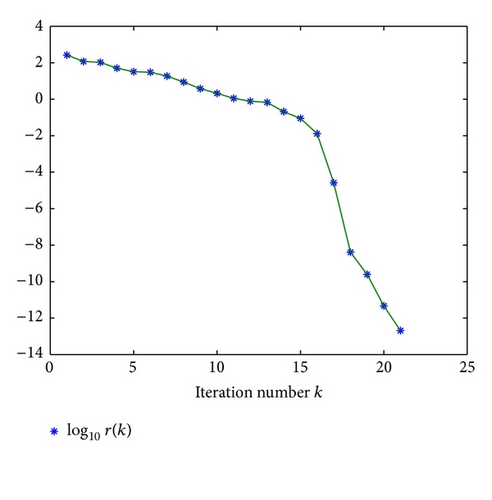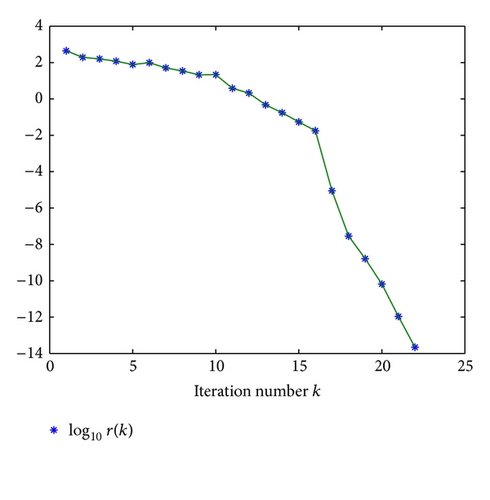Iterative Algorithm for Solving a Class of Quaternion Matrix Equation over the Generalized (P, Q)-Reflexive Matrices
Abstract
The matrix equation which includes some frequently investigated matrix equations as its special cases, plays important roles in the system theory. In this paper, we propose an iterative algorithm for solving the quaternion matrix equation over generalized (P, Q)-reflexive matrices. The proposed iterative algorithm automatically determines the solvability of the quaternion matrix equation over generalized (P, Q)-reflexive matrices. When the matrix equation is consistent over generalized (P, Q)-reflexive matrices, the sequence {X(k)} generated by the introduced algorithm converges to a generalized (P, Q)-reflexive solution of the quaternion matrix equation. And the sequence {X(k)} converges to the least Frobenius norm generalized (P, Q)-reflexive solution of the quaternion matrix equation when an appropriate initial iterative matrix is chosen. Furthermore, the optimal approximate generalized (P, Q)-reflexive solution for a given generalized (P, Q)-reflexive matrix X0 can be derived. The numerical results indicate that the iterative algorithm is quite efficient.
1. Introduction and Notations
Quaternion matrix equation is one of the topics of very active research in matrix theory and applications, and some important results have been developed. For example, Kyrchei [1] derived the explicit representation formulas for the minimum norm least squares solutions of quaternion matrix equations AX = B, XA = B, AXB = D. Yuan and Liao [2] derived the expressions of the least squares (j-self-conjugate) solution with the least norm of the quaternion matrix equation . Song et al. [3] obtained the expressions of the explicit solutions of quaternion matrix equations XF − AX = BY and . He and Wang [4] studied the necessary and sufficient conditions for the existence of a solution to the quaternion matrix equation A1X + (A1X) η* + B1Y(B1) η* + C1Z(C1) η* = D1 and derived a general solution when the equation is solvable.
The definition of generalized (P, Q)-reflexive matrix can be found in [5]. A complex matrix A is called (P, Q)-generalized reflexive (generalized anti-reflexive) if A = PAQ (A = −PAQ), where P and Q are two generalized reflection matrices; that is, P = PH = P−1 and Q = QH = Q−1. The generalized (P, Q)-reflexive matrices have been widely used in engineering and scientific computations [5–7]. Throughout, we use to denote the set of m × n generalized (P, Q)-reflexive quaternion matrices.
However, to our best knowledge, the generalized (P, Q)-reflexive solution of (1) over the quaternion algebra ℍ has not been considered so far. Due to the noncommutativity of ℍ, some well-known equalities for complex and real matrices no longer hold for quaternion matrices, which make the study of quaternion matrix equation more complex than that of real and complex equation. Motivated by the work mentioned previously and keeping the interests and wide applications of quaternion matrices in view (e.g., [37–47]), we, in this paper, consider an iterative method for the following two problems.
Problem 1. For given matrices Al, Cs ∈ ℍp×n, Bl, Ds ∈ ℍn×q, l = 1,2, …, u, s = 1,2, …, v, F ∈ ℍp×q, and the generalized reflection matrices P ∈ ℍn×n, Q ∈ ℍn×n, find that , such that
Problem 2. When Problem 1 is consistent, let its solution set be denoted by SX. For a given (P, Q)-reflexive matrix , find , such that
The matrix equation (2) plays important roles in the system theory [48–50]. Moreover, (2) obviously includes the matrix equations AXB + CXTD = F, AX + XTD = F, and AXB = C as special cases, which have been investigated in [17, 28, 36, 51–53].
Throughout this paper, ℝm×n and ℍm×n represent the set of all m × n real matrices and the set of all m × n matrices over the quaternion algebra ℍ = {a1 + a2i + a3j + a4k∣i2 = j2 = k2 = ijk = −1, a1, a2, a3, a4 ∈ ℝ}. We use AH, AT, , tr (A), R(A), Re(A), and vec (A) to denote the conjugate transpose, the transpose, the conjugate, the trace, the column space, the real part, and the mn × 1 vector formed by the vertical concatenation of the respective columns of a matrix A; respectively. We use ∥A∥ to denote the Frobenius norm of A, that is, . The Kronecker matrix product and Hadamard matrix product of the matrices A and B are denoted by A ⊗ B and A⊙B. We use I to denote the identity matrix with the appropriate size.
2. Preliminaries
In this section, we provide some results which will play important roles in this paper.
Firstly, we recall the definition of real inner product space. Then we define a real inner product in the space ℍm×n over the field ℝ.
Definition 3 (see [54].)A real inner product space is a vector space V over the real field ℝ together with an inner product defined by a mapping
- (1)
Symmetry: 〈x, y〉 = 〈y, x〉;
- (2)
Linearity in the first argument: 〈ax, y〉 = a〈x, y〉, 〈x + y, z〉 = 〈x, z〉 + 〈y, z〉;
- (3)
Positive definiteness: 〈x, x〉 > 0 for all x ≠ 0.
Lemma 4 (see [55].)Let A be an m × n matrix. There is a commutation matrix P(m, n) such that
Lemma 5 (see [55].)Let A be an m × n matrix and B a p × q matrix. There exist two commutation matrices P(m, p) and P(n, q) such that
3. An Iterative Algorithm for Solving Problem 1
In this section, we firstly construct an algorithm for solving Problem 1. Then we show that if the problem is consistent, the sequence {X(k)} generated by the introduced algorithm converges to a solution of Problem 1 within at most 4pq iteration steps.
Algorithm 6. (1) Input matrices Al,Cs ∈ ℍp×n, Bl, Ds ∈ ℍn×q, l = 1,2, …, u, s = 1,2, …, v, F ∈ ℍp×q, generalized reflection matrices P ∈ ℍn×n, Q ∈ ℍn×n, .
(2) Calculate
(3) If R(k) = 0, or R(k) ≠ 0 and T(k) = 0, stop; otherwise k : = k + 1.
(4) Calculate
(5) Go to Step (3).
The following Lemmas show some properties of Algorithm 6.
Proof. One has the following:
Therefore, the conclusion (19) holds. Consider
Therefore, the conclusion (20) holds.
Lemma 8. Assume that the sequences {R(i)} and {T(i)} are generated by Algorithm 6, and then 〈R(i), R(j)〉 = 0 and 〈T(i), T(j)〉 = 0 for i, j = 1,2, …, i ≠ j.
Proof. Since 〈R(i), R(j)〉 = 〈R(j), R(i)〉 and 〈T(i), T(j)〉 = 〈T(j), T(i)〉 for i, j = 1,2, …, we only need to prove that 〈R(i), R(j)〉 = 0 and 〈T(i), T(j)〉 = 0 for 1 ≤ i < j.
Now we prove this conclusion by induction.
First, we prove
Next, assume that 〈R(i), R(i + r)〉 = 0 and 〈T(i), T(i + r)〉 = 0 for i ≥ 1 and r ≥ 1. We will prove that
Lemma 9. When Problem 1 is consistent, let be its solution; then, for any generalized (P, Q)-reflexive initial matrix , the sequences {R(i)}, {T(i)} and {X(i)} generated by Algorithm 6 satisfy
Proof. When i = 1, it follows from Algorithm 6 that
Assume that (34) holds for i = t, and then, when i = t + 1,
Remark 10. Lemma 9 implies that if there exists a positive integer i such that R(i) ≠ 0 and T(i) = 0, then Problem 1 is not consistent. Therefore, the solvability of Problem 1 can be determined by Algorithm 6 in the absence of round-off errors.
From Lemmas 8 and 9, we have the following theorem.
Theorem 11. Assume that Problem 1 is consistent, and then using Algorithm 6 for any generalized (P, Q)-reflexive initial matrix , a solution of Problem 1 can be obtained within finite iteration steps in the absence of round-off errors.
Proof. If R(i) ≠ 0, i = 1,2, …, 4pq, from Lemma 9 we can obtain T(i) ≠ 0, i = 1,2, …, 4pq. Thus R(4pq + 1) and T(4pq + 1) can be computed by Algorithm 6. According to Lemma 8, we have 〈R(i), R(j)〉 = 0, i, j = 1,2, …, 4pq. Considering that the inner product space (ℍp×q, ℝ, 〈·, ·〉) is 4pq-dimensional, we know that the set of R(1), R(2), …, R(4pq) is an orthogonal basis of the inner product space (ℍp×q, ℝ, 〈·, ·〉). Also from Lemma 8, we have 〈R(i), R(4pq + 1)〉 = 0 for i = 1,2, …, 4pq, which implies that R(4pq + 1) = 0; that is, X(4pq + 1) is a solution of Problem 1.
4. The Solution of Problem 2
In this section, we will prove that the sequence {X(k)} generated by Algorithm 6 converges to the least Frobenius norm generalized (P, Q)-reflexive solution of the quaternion matrix equation when an appropriate initial iterative matrix is chosen. Then, we solve Problem 2 by finding the least Frobenius norm generalized (P, Q)-reflexive solution of a new constructed quaternion matrix equation.
Lemma 12 (see [51].)Assume that the consistent system of linear equations My = b has a solution y0 ∈ R(MT); then, y0 is the unique least Frobenius norm solution of the system of linear equations.
Lemma 13. If Problem 1 is consistent, then the following system of real linear equations is consistent:
Furthermore, if the solution sets of Problem 1 and (37) are denoted by SX and SY, respectively, then,
Proof. If Problem 1 is consistent, let X be a solution of Problem 1, then we have and PXQ = X, which implies that X is a solution of quaternion matrix equations
By (8), (9), and (12), we can derive that the quaternion matrix equations (39) is equivalent to the following real matrix equations:
By the operation properties of vec (·), ⊗, ⊙, and Lemma 4, it is not difficult to verify that matrix equations (40) is equivalent to
From the previous procedure, the proof of (38) is trivial.
Theorem 14. If is a solution of Problem 1 and can be expressed as the following form:
Proof. By (8), (9), (10), and (12) and Lemmas 4 and 5, we have
Noting (11), we derive from Lemma 13 that is the least Frobenius norm solution of Problem 1.
Remark 15. From Algorithm 6, we can derive that if we choose , G ∈ ℍp×q, as the initial iteration matrix, then all X(k) generated by Algorithm 6 have a form of
Theorem 16. When Problem 1 is consistent, if we choose the following matrix as the initial iteration matrix
From conclusion (44) and Theorem 14, the proof of Theorem 16 is trivial.
5. Examples
In this section, we give two examples to illustrate the performance of the proposed algorithm.
Example 17. Consider the quaternion matrix equation

Example 18. Let
So we can obtain the solution of Problem 2; that is,

6. Conclusions
In this paper, an algorithm has been presented for solving the quaternion matrix equation over generalized (P, Q)-reflexive matrices. It has been proven that when the quaternion matrix equation is consistent over generalized (P, Q)-reflexive matrices, for any generalized (P, Q)-reflexive initial iterative matrix, the sequence {X(k)} generated by Algorithm 6 will converge to a generalized (P, Q)-reflexive solution within finite iteration steps in the absence of round-off errors. We have also proven that by choosing a suitable initial iterative matrix, the sequence {X(k)} will converge to the least Frobenius norm generalized (P, Q)-reflexive solution of the quaternion matrix equation . Then, by using Algorithm 6, we solved Problem 2. The numerical results have shown that the presented algorithm is quite effective.
Acknowledgments
This research was supported by the grants from the Innovation Program of Shanghai Municipal Education Commission (13ZZ080), the National Natural Science Foundation of China (11171205), and the Natural Science Foundation of Shanghai (11ZR1412500).




